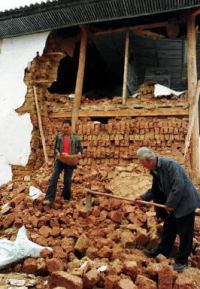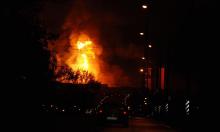Strong earthquake shakes southwestern Chinese region
A strong earthquake shook a hilly southwestern Chinese region near the Lao border, killing at least three people, injuring hundreds and forcing 120,000 people from their homes.

The 6.4-magnitude quake struck the county seat of Ning'er shortly after 5:30 a.m. (2130 GMT Saturday), said China's official Xinhua News Agency, citing the government's seismological bureau. The U.S. Geological Survey measured the quake's magnitude at 6.2.
At least three people died and more than 290 were injured, 15 seriously, Xinhua reported. One of the dead was a 5-year-old boy who was crushed by debris, state television reported. The boy's parents were also trapped but were rescued by local residents, China Central Television said.
"I didn't notice the initial quake and was woken up by my parents, and we ran out of our home," said a woman in her 20s who lives in Ning'er County and refused to give her name when reached by phone.
She said the initial quake lasted about one minute and that many residents fled their homes to find safety in open areas.
Others moved into tents after their homes were damaged, said a retired schoolteacher who only gave her surname, Dong.
"Many old buildings, especially those built in the 1970s, either have cracks in the walls or have collapsed," Dong told The Associated Press by phone.
News footage aired on China Central Television showed partly collapsed brick homes and soldiers knocking down unstable structures. Doctors and nurses treated the injured in a large tent.
Rescue teams with thousands of tents, quilts and other relief supplies were rushing to the area, Xinhua reported.
Ning'er lies in a quake-prone mountainous region in Yunnan province about 150 kilometers (90 miles) north of Laos and is famous for its strong tea, known as Pu'er. For centuries, the area sat astride an important trade route for tea and horses that ran along western China between central Asia and southeastern Asia.
Many of the area's residents belong to the Hani and Yi minority groups that once thrived in small hillside villages but have in recent decades moved into the county seat.
The quake damaged pipes, cutting off water supplies, and though electricity was still on in some areas, shops and schools were closed, Dong said.
Xinhua said communications lines were also downed, making it difficult for residents to make phone calls.
By 2 p.m., the local seismological bureau recorded 233 aftershocks, the strongest with a magnitude of 5.1, said an official with the bureau who gave only his surname, Ma.
The evacuation of 120,000 residents was ordered after many buildings were deemed to be unsafe, Ma said. He said the seismological bureau was among many offices and homes in the area where walls had cracked.
The quake could be felt as far as 300 kilometers (185 miles) away, Xinhua said.
Twenty temblors above magnitude 5.0 have hit the area since 1990, Xinhua said.
In 1988, a 7.1 magnitude quake in Yunnan near the border with Myanmar killed more than 930 people. More than 15,000 people died after a magnitude-7.7 earthquake in the province in 1970, though authorities at the time covered up information on casualties and damage amid the chaos of the Cultural Revolution.
Subscribe to Pravda.Ru Telegram channel, Facebook, RSS!




